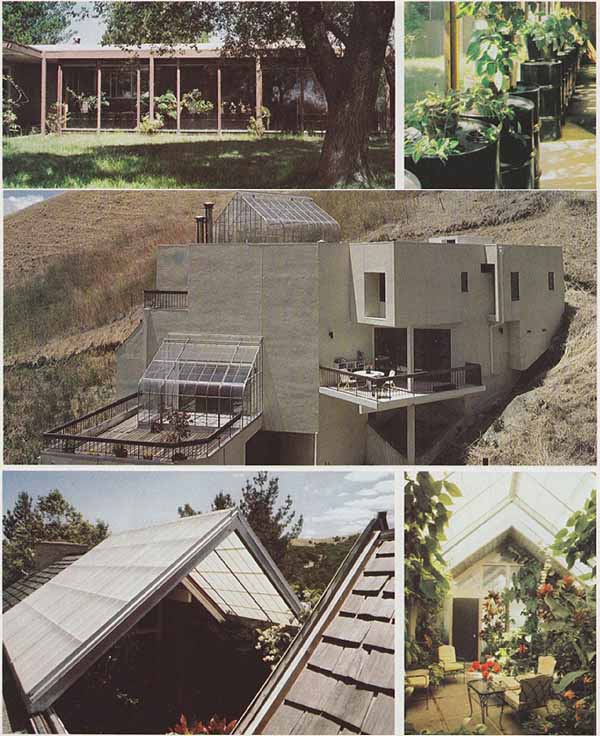It’s not necessary for you to invest in a complete, packaged solar system for thousands of dollars to take advantage of the suns heat. Here are some ways to use the sun’s heat without enormous outlays of money.
• Specially painted Venetian-type blinds: Painted flat black on one side and shiny silver on the other, these blinds can serve two purposes. When the silver side faces the sun, it helps deflect the sun’s heat—a cooling boon in hot summer weather. and when the black side faces the sun, the blinds themselves become solar collectors. By adjusting the angle of the slats, you can direct the heat collected by the black panels back into the room. A sophisticated version of this solar heat- collecting method installs the blinds between the two panels of a double-glazed window.
• Reflectors: A reflector outside the window will reflect the sun’s rays from the ground into your window. You can use what’s already there—asphalt, or concrete (both will reflect between 1/4 and 1/3 of the rays that strike it); or fresh snow (which will reflect nearly 90 percent of the rays that strike it). Or you can improve on what you’ve got by buying or building a reflector made of tinfoil, Mylar, white porcelain, mirrors, white rock or sand—in fact, almost anything reflective. Just make sure that fragile materials won’t be damaged by fencing them in, away from animals, children, etc. You can also use reflectors inside. (See photos belows.)
A reflector can also be part of an insulating wall that’s lowered by day to collect solar heat, and raised at night to insulate your living space.
• Masonry: If you’re willing to roll up the rug—permanently—you can create a direct-gain thermal mass by replacing your carpeting with floors made of masonry tiles, stone, brick, or concrete. These floors can be extremely attractive, as shown in the photograph. The same principle applies to walls; but unless you are building your house from scratch, you probably will not relish replacing your walls.
• Greenhouse: Add a greenhouse to the south wall of your house. This works especially well if the south wall already has a door or window. Both full green houses and window-box greenhouses will provide indirect gain passive solar space heating. If you are interested in this aspect of solar heat, be sure to see our How to Build and Use Greenhouses which details the construction of a wide variety of greenhouses.
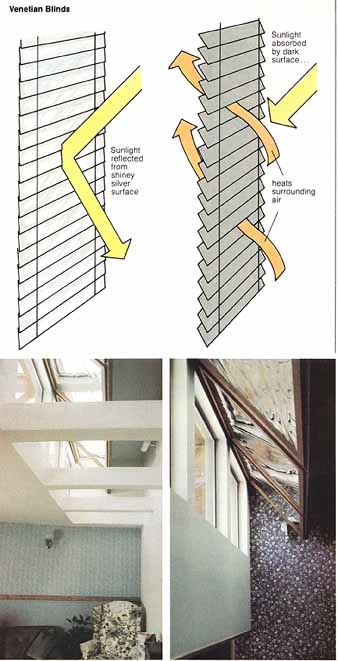
(top) Venetian Blinds; (bottom) Reflectors can be used inside as
well as outside to increase the amount of solar heat—and light—available to you.
Make sure incoming light strikes your reflectors at an angle that will send the
rays into your house, where you want them, instead of back out the window. Any
kind of material that has a high reflective ability can be used for this purpose,
although mirrors, porcelain, decorative metals, and metal fabrics are
most commonly used.
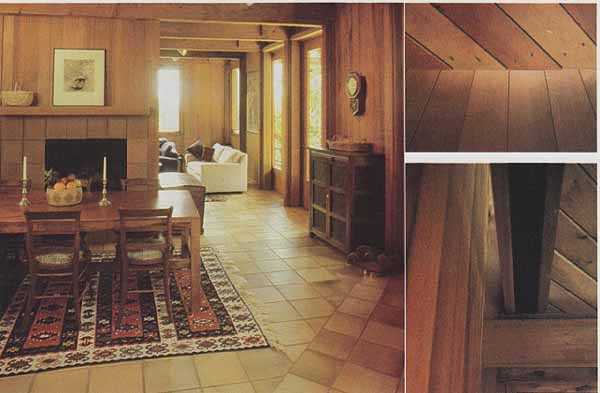
Solar heating components can be beautiful as well as functional.
The masonry floor in the photograph above (left), for instance, is a very
well disguised heat sink—a stone mass which absorbs the heat from direct
sunlight during the day, and stores it for nighttime use. The floor automatically
radiates its stored heat when the air surrounding it cools below the temperature
of the floor. The construction of the wooden walls (right) includes openings
that act as vents or ducts to allow air to circulate within the house,
carrying solar warmth throughout the house from the room in which it is
collected, or from the masonry floor at night.
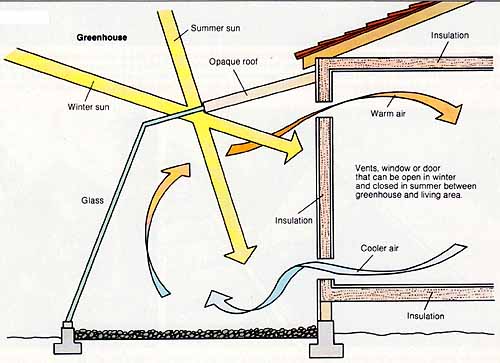
Greenhouse: Vents, window or door that can be open in winter and closed in summer between greenhouse and living area.
(top) Careful engineering and thoughtful architecture allow the sun to do nearly all the work heating this house. Massive masonry walls act as heat sinks, absorbing and storing heat by day for re-radiation to the building’s interior at night. Three greenhouses trap the sun’s heat for distribution by circulating fans and a system of ducts. The topmost greenhouse, which is the hottest, is used for growing cactus; the second has high masonry walls and is used for growing vegetables; the lowest greenhouse is used as a sitting room in which a variety of plants also grow.
(middle) This sunspace is only a few feet wide, and was constructed expressly as a way of collecting solar heat. Heat is not only trapped inside the greenhouse-like space; it is also absorbed by and stored in the black-painted drums full of water. Heat can then be passed into the house by convection through a system of ducts at the top and bottom of the wall separating the sunspace from the living space of the house.
(bottom) The addition of a sliding roof over what had been open space adds both a room and a solar heat collector to another house. The frosted glass roof admits and traps the sun’s heat; but because the roof slides open, excess heat can also be vented easily at any time.
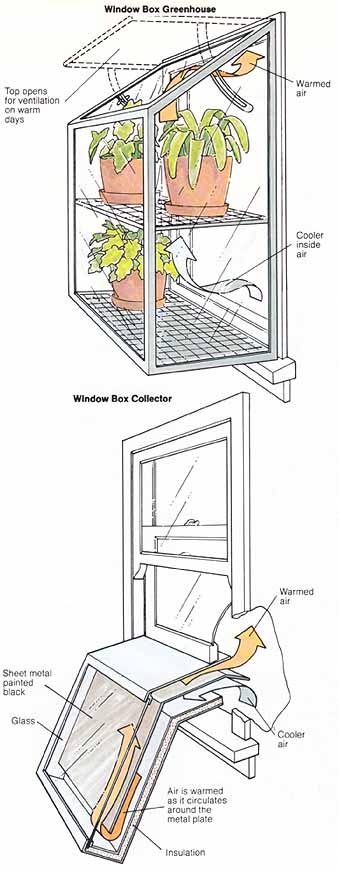
Window Box Greenhouse; Window box collector
• Solarium or sunspace: You can add a solarium, or sunspace, on one side of the outside walls. In principle, a sun- space is similar to a greenhouse—in fact, some people use it for that purpose. It is used to collect the excess heat brought in through doors, windows, or floor and ceiling vents. If you have a room with a good south-facing, sun-catching window, adding a sunspace can augment the existing passive solar heating system. If you don’t have a room with a good southern exposure, but do have one with a good east or west exposure and a little building space around it on which to develop a new southern exposure, that will work well also. Ideally, the entire south wall of the sunspace will become a collector.
For the floor, you can use a massive heat sink of some sort—masonry, stone, or concrete—which must be insulated from underneath, to keep maximum heat inside the sunspace. For addition al heat storage, you can use rock-bed storage or water-filled drums. If the wall between the potential sunspace and the house is currently an outside wall and you want to keep the rooms separate, be sure to insulate that wall, Make sure it has vents or ducts that are easy to open and close. A door between the rooms can provide additional heat transfer control.
• Drums or culvert pipes: Paint a group of 55-gallon drums or culvert pipes black, set them in a south window, fill them with water, and you’ll get a lot of solar heat for your effort. Units of contained water are easy to put in the window, in the path of direct sun light. You can stack the drums on top of one another, or on their sides on racks. The drums themselves cost about $25 each from wholesale gasoline distributors although they are not usually treated to retard corrosion.
• Metal or plastic cylinders: You can buy metal or plastic cylinders specifically designed to be filled with water, as you would the drums. Although the cylinders cost somewhat more than drums, they are more attractive and are not so susceptible to corrosion.
• Window-box collector: Make or buy a window-box collector. It attaches to a south-facing window and pulls the cooler air from the floor through the collector, while the air passing over the absorber heats and rises. In other words, it uses the principles of thermosiphoning to provide indirect gain passive solar space heating. It will provide low- cost heating during the daytime only, since it can’t store the heat at night. Therefore, you should be able to close it off with a small door or other seal, to keep the process from reversing itself at night. Thermosiphoning does not know indoors from out—it only knows movement from warmer to cooler.
• Trombé wall: The Trombé wall was originally developed in 1956 by Jacques Michel, an architect, and Felix Trombé, a scientist. Despite variations since that time, its basic form hasn’t really changed. A black-faced masonry or concrete south-facing wall, 12 to 16 inches thick, is used as the solar collector, but the wall itself is placed a few inches behind a sheet of glass. As the sun warms the air between the two surfaces, the air rises. At the top of the stone wall, ducts or vents allow the warmed air to pass into the room; at the bottom of the wall, ducts or vents allow cool air to return to be heated. All day, the natural thermo-siphon process keeps warm air in the room; and because the heat takes from 6 to 8 hours to pass completely through this thickness of stone, the radiant heat from the wall itself warms the room at night. Dampers can be placed in the vents to prevent warm air from escaping through them at night.
• Tube wall: The tube wall resembles the Trombé wall, but instead of a masonry or concrete wall, a series of water- filled culvert pipe sections are placed vertically from floor to ceiling. A glazing on the south wall lets the sunlight pass through, warming the water in the tubes. At night, an insulated flap is placed between the water tubes and the outside air to radiate the heat into the room. The insulating flap can also be reflectorized to direct more of the sun’s rays to the tubes during the day.
• Roof pond: The roof pond is basically a large plastic waterbed mattress placed on a flat, dark, metal roof. During the day, the roof cover is opened to the sun; solar heat is collected by the dark roof itself and stored in the water bags. At night, insulated panels are closed over the water bags, allowing the absorbed heat to radiate down into the room.
The roof pond offers a natural solution to the problem of solar air conditioning—its whole process can simply be reversed in summer. The roof can be closed during the day, absorbing excess heat from the room below; and it can be opened at night to release its stored heat to the cool night air.
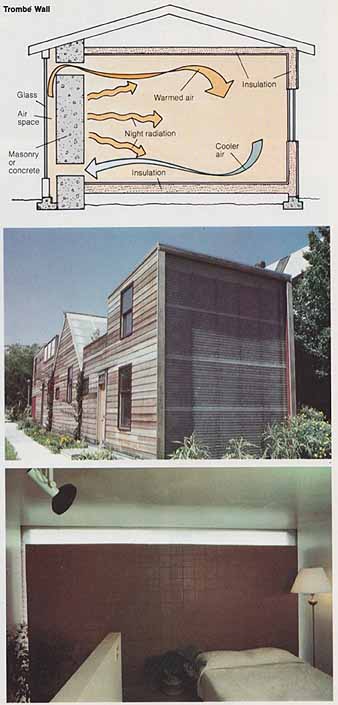
(Above) From the outside, the Trombé wall need not look very different
from any other exterior wall. It should face south, in order to receive
as much direct sun light as possible. It absorbs the sun’s heat for use
warming the inside (below) both by radiating the warmth it has absorbed and stored in its mass, and by convection, when the warmed air rises and passes into the room through the open space at the top. Cooled air returns
to the wall through an open space at the bottom of the wall.

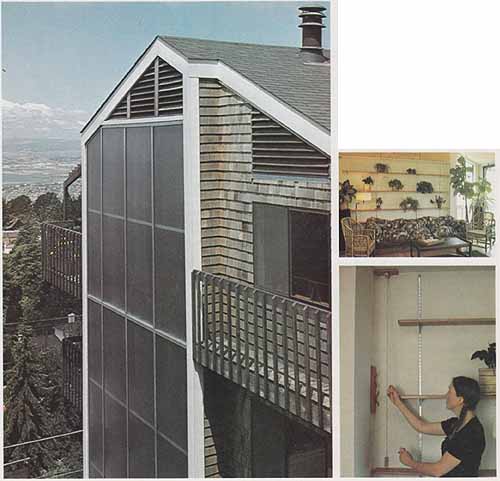
Roof Pond; Tube Wall: The tube wall is another way to use water
for storing solar heat. Massive containers of water, placed in a southern
wall, are exposed to the sun (left and top). The heat they absorb is radiated
to the interior of the house through the wall itself (below), or else warms
the living space by convection when operable vents are opened (bottom).
Particularly in cooler climates, it is important to be able to control the
flow of air between the tube wall and the living space, since the water
might become colder than the interior of the house at night, and would then
begin to take heat away from the house, placing unnecessary demands on any
conventional auxiliary heating system.
Next: Active Solar System
